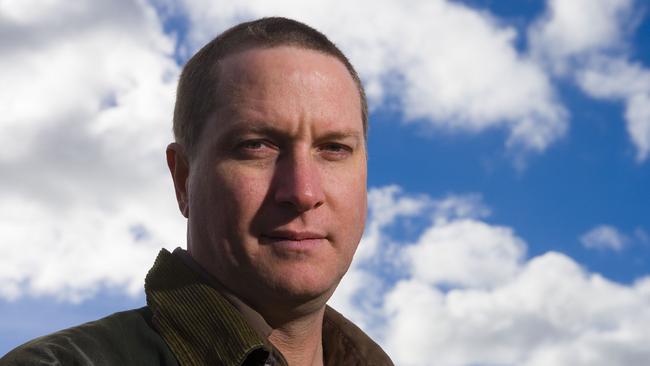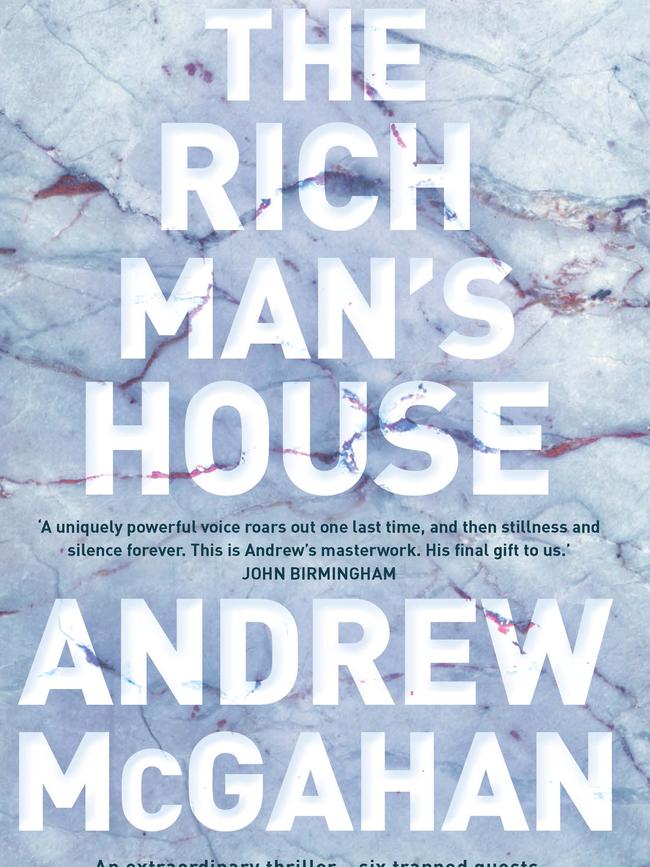A measure of puny humans
Andrew McGahan’s final work draws on past fantastic fiction and reworks it based on contemporary concerns.

So many and varied are the reasons to find The Rich Man’s House — Australian author Andrew McGahan’s final, posthumously published novel — problematic that, initially at least, it’s hard to understand why the book succeeds so mightily. Thin characterisation, workmanlike dialogue and a surpassingly strange premise are just a few of the flaws that glare back at those trained to a more orderly reading experience.
Yet McGahan’s story bores into the bones and lingers there, a form of narrative radiation. It isn’t until the story’s bizarre, grand guignol conclusion that a suspicion is clarified.
To read this as a ‘‘literary’’ novel is to use the wrong yardstick. Its triumph is won according to another set of measurements. This is imperial fiction, not the usual metric.
The reviewer’s first task, then, is to scramble up the family tree and identify the true antecedents of a book such as The Rich Man’s House. Think of those purveyors of slow-dawning horror, Edgar Allan Poe and HP Lovecraft.
Or later on, JG Ballard’s science fiction and the madder fringes of William Burroughs’s body of work. Closer to the present we have the macabre vision of Stephen King, China Mieville’s political fabulism and the modern environmental uncanny of Jeff VandenMeer’s Southern Reach trilogy.
For all these writers, imagination rules supreme: almost all else is subservient to the oddity of the author’s vision. Generic conventions buckle and warp under the pressure of their imaginings. Rational plot, believable dialogue, a neat structure in terms of place and time are petty encumbrances for such figures, who are after bigger game.
In place of psychologically plausible human characters, for example, they present us with monstrous aliens or Indian burial grounds, or even giant whirlpools. And instead of working along timescales of no more than several human generations, they try to encompass whole eras or geological epochs. They dream in deep time.

So, The Rich Man’s House could be regarded as a huge and ambitious excursion into the genre known as New Weird. It draws on the long tradition of fantastic fiction listed above and seeks to rework it according to contemporary social, political or ecological concerns.
Especially when paired with McGahan’s preceding novel from 2009, Wonders of a Godless World, it reveals an author who, despite running the gamut of genres and modes — from the grunge-y Praise of 1991 to the antipodean gothic of his Miles Franklin-winning The White Earth in 2004 — was pushing out in a wholly new direction before his untimely death from pancreatic cancer early this year.
The novel opens in 2016 with news of the sudden death of a celebrated Australian architect named Richard Gausse. Gausse is best-known for his ‘‘buried’’ style of design. Imagine Hobart’s MONA, a building carved upside-down into the rock of a waterfront cliff, and you’ll get the idea: posh bunkers for the rich and famous.
His last commission is his most ambitious: a cavernous mansion, hewn from the inside of a mountaintop, on an isolated landmass in the Southern Ocean named Theodolite Island, halfway between Tasmania and the Antarctic. Yet that peak is just a minnow compared with the mountain that sits beside it, rearing up out of the ocean to a height twice that of Everest: 25,017m.
That Ur-mountain — known as The Great Wheel — of course does not exist. But by using invented interpolated chapters from works of history and journalism throughout the main narrative, McGahan makes a decent fist or rendering the preposterous plausible. It turns out that the peak was first sighted by a Dutch seaman named Gerrit Jansz, when his ship was briefly separated by a storm from Abel Tasman’s lead vessel during that momentous voyage of 1642.
The author hives off just enough fact from subsequent history to draw the mountain into the larger account of southern exploration and colonial annexation to the present. Du Fresne rediscovers the site of the island more than a century after Jansz. Soon afterwards, James Cook claims Theodolite Island for Britain and sends a young William Bligh to perform the first recce of the foothills of its immense sister peak. It becomes a site of Cold War competition and, ultimately, a meteorological and scientific research station under Australian control.
But mostly it becomes the mecca for climbers that Everest was during our 20th century, a giant to be conquered by man. Following countless false starts and failures — a period when the mountain claims the lives of George Mallory and Edmund Hillary, among others — a team in 1974, using suits adapted from those employed during the Apollo moon landing, manages the ascent.
For mysterious reasons, however, only one person reaches the absolute summit out of the hundreds-strong team of mountaineers. He is the leader and funder of the expedition, a driven and amoral heir to an American fortune named, appropriately enough, Walter Richman.
It is Richman, far wealthier still after almost 50 years, who has chosen to return to the site of his early triumph. It is his sub-Antarctic palace that Gausse designed — and it is here, too, that the architect died.
When the billionaire extends an invitation to Gausse’s eldest daughter, Rita, via his personal assistant at the architect’s Sydney funeral, to stand in for her father at the dwelling’s private opening, she is surprised and resistant.
Relations with her father had been fraught for years. She was the black sheep of the family: drugs and alcohol mainly, though she has lived more quietly since a disturbing, violent mental breakdown during a flight to America years before. These days she is a trainee vet, living on the green fringes of suburban Melbourne, keen to leave the lunacy of her youth and young adulthood behind.
Richman is not the kind of man to take no for an answer, though. Rita eventually accedes to his request. The story opens properly with her arrival on Theodolite Island, to a dwelling that makes Charles Foster Kane’s Xanadu look like a garden shed.
And what the reader understands, via Rita’s awed and appalled reaction to the place, is that its construction and placement represent an act of hubris that almost demands some godly take-down.
But nemesis is (notwithstanding its mythological trimmings) a construct of human culture, while the island, despite Richman’s domestic lavishments, is as far removed from the human world as any individual is likely to get. This, then, is a novel about non-human forces and their response to the arrogance and destructive tendencies of our kind.
If all this sounds like heavy material to drag across 600-plus pages, it isn’t. For the most part the novel proceeds like a country house murder mystery obliged to share a Hollywood backlot with a slasher flick. Like these more traditional generic forms, The Rich Man’s House is engrossing in its growing awfulness, its air of mounting dread, its casual subtraction of men and women from the tally of the living.
But if that were all the novel had to offer, we could leave it in a stack at the airport bookstore. While it is hard to explain much without spoilers, what can be said is that the Great Wheel is as much a character of the novel as Walter Richman, Rita and the small cast of supernumeraries who end up trapped together, 2½ kilometres above sea level on Theodolite Island.
What becomes clear is that Richman, all those years before, failed to properly propitiate the mountain he conquered. What’s worse, he may well have performed an act of desecration at its peak instead.
This rather superstitious approach is not without real-world analogues. Tibetan Sherpas, for instance, were superb climbers who nonetheless left certain Himalayan summits purposefully untrodden. It was believed that admonishments would follow to those who exceeded certain human bounds.
McGahan, using Rita and her unruly youth as a kind of drugged-out psychic of non-human sentience, parlays this indigenous idea into a metaphysics of place. In doing so, he wrenches an ordinary if thrilling human story out of its comfortable frame and then proceeds to remove the hinges and take a jackhammer to the walls.
The author wants to register the puniness of human activity in the face of the inscrutable alien mass of the Great Wheel, as a way of resizing our mental maps.
There is a tension here, admittedly: the forms McGahan uses to prosecute his novel are so off-the-peg that they can fit awkwardly with ideas that sit outside our mind’s processing ability. But as Ludwig Wittgenstein once put it, ‘‘if a lion could speak, we could not understand him’’. By which he meant that non-human sentience does not translate into human meaning, that meaning belongs to the private context in which an animal, or a plant, or a giant mountain rearing out of the Southern Ocean exists.
What the best works of weird literature do is intentionally rub old human tropes against subjects or objects that are inaccessible to human awareness. The reader enters The Rich Man’s House as an aficionado of the comfortable narrative structures we weave around our world. They leave its pages shaken by the thought that the world is indifferent to the tales we have to tell: indeed, it could extinguish all of them in a geological blink, without a conscious thought.
Geordie Williamson is chief literary critic of The Australian.




To join the conversation, please log in. Don't have an account? Register
Join the conversation, you are commenting as Logout